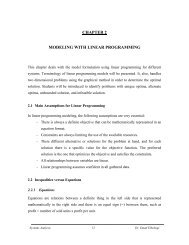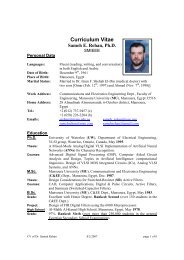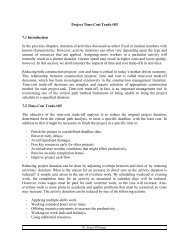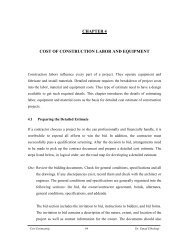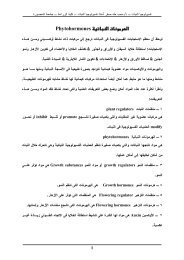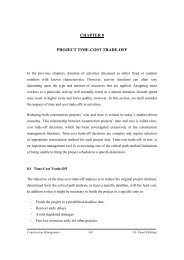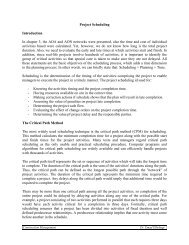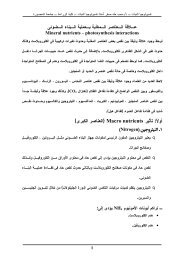Thyroid and Parathyroid
Thyroid and Parathyroid
Thyroid and Parathyroid
Create successful ePaper yourself
Turn your PDF publications into a flip-book with our unique Google optimized e-Paper software.
process <strong>and</strong> always should be meticulously cleared along with paratracheal nodes<br />
(central neck node dissection). In patients with palpable cervical nodes or involved<br />
central neck nodes, ipsilateral or bilateral, bilateral modified radical neck dissection is<br />
recommended. Similarly, patients with MTCs larger than 2 cm should undergo<br />
ipsilateral prophylactic modified radical neck dissection, because more than 60<br />
. percent of these patients have nodal metastases<br />
If superior mediastinal lymph nodes are noted at operation they also should be<br />
removed, although it is rarely necessary to perform a median sternotomy. Surgeons<br />
should be prepared to sacrifice the recurrent laryngeal nerve when it is involved in the<br />
tumor mass. Though this does not occur frequently, the possibility should be<br />
. discussed with the patient preoperatively<br />
Tumor debulking in cases of metastatic disease or local recurrence should be<br />
undertaken. This frequently ameliorates symptoms of flushing <strong>and</strong> diarrhea, <strong>and</strong> it<br />
. helps in decreasing the risk of death resulting from recurrent central neck disease<br />
External-beam radiotherapy for patients with tumors at resection margins or<br />
unresectable tumors is controversial. It is recommended for patients with unresectable<br />
residual or recurrent tumor, although the results are debatable. There is no effective<br />
. chemotherapy regimen<br />
When patients have associated conditions such as pheochromocytoma or<br />
hyperparathyroidism, these conditions also require careful evaluation.<br />
Pheochromocytomas should be operated on first, before thyroidectomy is performed.<br />
In most cases pheochromocytomas can be removed laparoscopically. In patients who<br />
have hypercalcemia at the time of thyroidectomy, the parathyroid gl<strong>and</strong>s should be<br />
identified <strong>and</strong>, when abnormal, selectively removed. In patients with normocalcemia,<br />
efforts should be made to preserve the parathyroid gl<strong>and</strong>s, which should be marked<br />
with a stitch or clip in patients with MEN IIA. When a normal parathyroid cannot be<br />
maintained on a vascular pedicle, it should be removed, biopsied to confirm that it is a<br />
. parathyroid, <strong>and</strong> then autotransplanted to the forearm of the nondominant arm<br />
Postoperative Follow-up <strong>and</strong> Prognosis<br />
Patients should be assessed at regular postoperative intervals, <strong>and</strong> serum calcitonin<br />
<strong>and</strong> CEA levels should be monitored regularly. Calcitonin level is more sensitive for<br />
detecting persistent or recurrent disease, <strong>and</strong> CEA for predicting outcome. In a study<br />
of 123 patients with MTC, Russell <strong>and</strong> colleagues reported that 67 percent of the<br />
patients whose MTC was confined to the thyroid were clinically <strong>and</strong> biochemically<br />
(calcitonin) free of disease (mean follow-up time 5.5 years), compared to only 8<br />
percent of patients who had extrathyroidal spread. A later paper from the same group<br />
reported on 31 patients who, despite having adequate primary operations for MTC,<br />
had persistently raised calcitonin levels. The 5- <strong>and</strong> 10-year survival rates for these<br />
patients were 90 percent <strong>and</strong> 86 percent, respectively, with only two patients dying<br />
from MTC. Postoperatively raised calcitonin levels are frequently encountered <strong>and</strong><br />
. are a cause for concern signaling the need for evaluation<br />
When recurrent or metastatic MTC is suspected <strong>and</strong> suggested by rising calcitonin<br />
levels, localization studies for occult or clinically apparent disease should be used.<br />
The investigative tools available include CT, MRI of the neck <strong>and</strong> mediastinum,



